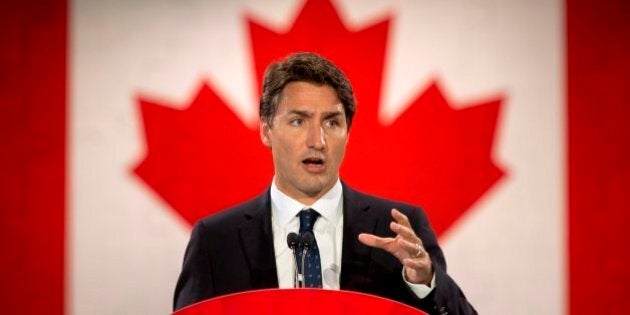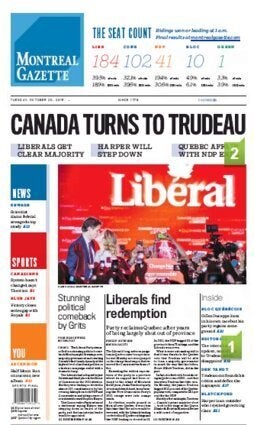
On Oct. 19, 2015, the Liberal Party, led by Justin Trudeau won the Canadian federal election with a historic majority win. What was most remarkable about the victory was not only how it surpassed all predictions, expectations and forecasts but also how large the gain was.
In the previous 2011 election, the Liberals were dealt a staggering defeat. With only 34 of the 308 available seats, their worst result in history relegated them to third party status for the first time since confederation.
This time was different. For much of the 78-day campaign, again one of the longest in history, all three major parties were in a tight three-way race. The last projection by the CBC poll tracker suggested 146 seats for the Liberals.
Yet on Election Day, a red wave took over, surprising everyone. Trudeau's Liberals first swept all 32 seats in the Atlantic Provinces, signalling a new momentum. They eventually won 39.5 per cent of the popular vote, 184 seats of the available 338, which was a phenomenal gain of 150 and a majority. This was also pretty much met the CBC poll tracker's best case scenario of 185. Not only did Liberals usurp many Conservative ridings, but also NDP strongholds.
So how did this happen? Here are seven key aspects of what lead to this dominant win and red wave of support.
1) Need for Change + Anti-Harper Sentiment = Red Wave
Typically, governments that have been around for at least two mandates generate whispers among the electorate for change. In the 2011 election, when Stephen Harper was going for his third mandate, there was already strong anti-Harper sentiment. This time the feeling was reaching profound levels. We saw social movements around the hashtag #StopHarper (and a few harsher ones), youth engagement events and even bands such as Blue Rodeo writing anti-Harper songs. People were looking for a clear alternative. They were organizing strategic voting initiatives, engaging in debate and encouraging everyone to vote.
The voter turnout was much higher than before. During advance polling, about 3.6 million ballots were cast over a four-day period -- an increase of 71 per cent over advance ballots in the 2011 election. The final voter turnout was 68 per cent compared to 61 per cent the previous election. One could even argue that results from the Atlantic of Liberal dominance in the east may have affected voting in the west (this of course is a flaw in our current system, but I digress).
This momentum for change, to remove Harper and to rally strategically around one solid alternative were key reasons for his success.
2) Trudeau Stayed Positive (Sunny Ways)
One of Harper's defining political strategies were his negative attack ads. He had great success with similar ads before on the last two leaders Michael Ignatieff and Stephane Dion. He poked fun at Trudeau's hair and tried to position him as "not ready" or with little experience. However, even NDP leader Thomas Mulcair, who was the front-runner when the campaign began, put out his own negative ads against both Harper and Trudeau.
Trudeau was the only one of the three major party leaders who did not go negative. This set him apart and resonated with the electorate who were tired of the same divisive politics. He virtually ignored and dismissed the rhetoric about his hair and so-called inexperience, even using humour as a tool to poke fun at himself. Ironically, it was reminiscent of Jack Layton's "love is better than anger" credo that helped him with his own orange wave in 2011.
Trudeau also reached out to his conservative neighbours and looked to unify Canadians with his message. He called out the divisive niqab issue and barbarian cultural practices hotline as playing politics of fear, which most Canadians agreed with. During his victory speech, Trudeau mentioned Abraham Lincoln's "we are not enemies, but friends" mantra and Wilfrid Laurier's philosophy of "sunny ways" as a motivating factor.
3) The Longer Campaign Actually Worked in His Favour
When Harper first launched the longer election campaign, most strategists saw this as an advantage to Harper. Indeed, had the election been shorter, we may have seen a much different result. However, this length played well to Trudeau's campaign, who had started out in third place.
After a slow start, a mediocre first televised debate and trying to shake off his Bill C-51 support, Trudeau started to find his groove. He listened, learned and grew more comfortable with the process, people and political game. He willingly changed his economic position to take on a deficit, which undercut Mulcair's balanced budget approach. During the last two debates, Trudeau hit some home runs. The final debate on foreign policy impressed many and was the first signal of a turnaround. Ultimately, the other two party leaders underestimated his ability to come up from third place.
4) Consistency of Message and Brand
One of the primary ways to break through any marketing clutter is brand consistency. Keeping the message and answers consistent will eventually hit the intended target. Even when taking a beating over his Bill C-51 support, once Trudeau explained why he made that choice, he explained it the same way repeatedly. He maintain a consistent positive energy, fresh demeanour and poise. He even allowed the media to ask whatever they wanted, which was another great way to get his message across.
5) Strongest Social Media Presence
Being a social media aficionado myself, I was looking to see how the political machines would use this powerful medium. For example, I noticed far more sponsored messages from Liberals than other parties did. One of Trudeau's main sponsored ads simply asked: "Thinking about voting Liberal or not? Yes or no, click here." This was targeted at both Liberal supporters, those on the fence and even voters who wanted to say "no."
Additionally, Trudeau gladly made himself available for selfies, photos, videos and more. The Liberal party created many other quotable memes, videos and photos, leveraging their virality in a stronger way than the other parties could.
6) Key Memorable Moments and One-Liners
One of the hardest things to do is catch voters' attention and cut through the noise with either memorable moments (that are shared virally) or zingers. Trudeau won with both.
During a debate he defended his father, former Prime Minister Pierre Trudeau, in an eloquent speech. Justin Trudeau had not brought him up much, for fear of being construed as "just Trudeau's son, nothing more." Nevertheless, it was a powerful moment and Trudeau continued with more key and memorable moments such as:
- Reaching out and promoting unity, also seen in a meme: "Conservatives are not our enemies, they are our neighbours."
- In a video, reprimanding his own people when they booed a reporter: "Hey, guys. We have respect for journalists in this country. They ask tough questions and they're supposed to."
- In an interview with VICE News addressing the youth vote where he said: "I'd love for you guys to vote Liberal, but I don't even care, as long as you vote."
- Finally in a quote that was shared via video and meme: "We don't need to convince them to leave the Conservative party, we just need to show them how Stephen Harper's party has left them."
7) Young, Personable and Real
As much as the Conservative attack ads made fun of Trudeau's hair, it does not hurt that he is young, attractive and personable. He has a unique charm, much like his father and has established a leadership brand that is accessible, authentic and real. This resonated with millennials, most of whom were looking for regime change and someone newer and closer to their vision of Canada.
He showed a great knack for listening, no matter who was talking him, whether they were youth, media or seniors. Before the election, a video of him went viral, where he was engaging an anti-marijuana critic. She turned out to be the spouse of an assistant to former Conservative Public Safety Minister Vic Toews. Trudeau was willing to embrace his vulnerability and make himself available to all.
Is Hindsight 20-20?
The Liberals led by Trudeau have a lot work ahead of them, but their surprising victory may not be the upset we all thought it was. When you combine a growing need for change with a fresh, newer face, who brings a positive, unifying and consistent message, we can see how the red wave momentum was waiting for us. Perhaps many of us did not see it because this election fired up many negative emotions and divisiveness. However, most Canadians saw right through that. The people of Canada were the one who lit the fire and fanned the flames across the country on election night.
MORE ON HUFFPOST:
